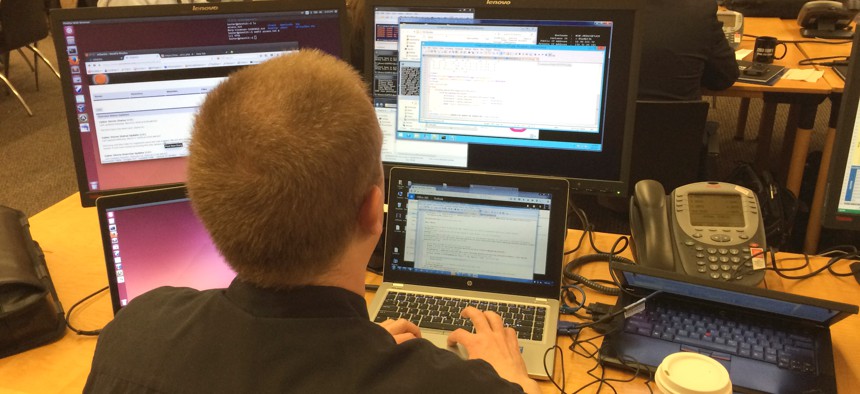
Mission control at Cyber Storm V in Washington, Tuesday, March 8, 2016. Tami Abdollah/AP
How One Intelligence Agency Is Opening Up to Startups
A invitation from the Pentagon's mapping arm could be the first of more outreach to early-stage private-sector companies.
One spy agency is moving past a reputation for mysterious activity by actively networking with commercial startups.
The National Geospatial-Intelligence Agency has recently been making deliberate efforts to meet early-stage private sector companies developing technology that might be viable to its multifaceted mission to provide intel for national-security efforts, and humanitarian and relief agencies.
Nextgov spoke with Erwin Godoy, chief innovation strategist at NGA’s Enterprise Innovation Office, about the agency’s broader goals. This conversation has been edited for length and clarity.
Godoy: For the most part, the government has tended to be very passive. We are sought-after customers by our traditional industry. We have traditional windows such as FedBizOpps—that’s usually where we kind of wait and see if people answer our requests.
While that worked for us great in the '90s and the first part of the decade … the rate of technological change, the rate of new companies coming out ... has just been so fast, coming out of Silicon Valley, often New York, Boston, these hubs are driving innovation in our economy at large. Most of these companies aren’t used to doing business with government; they don’t even know how to start.
Related: How One Intelligence Agency Is Opening Up to Startups
Related: Three Ways to Judge the Pentagon’s Tech-Sector Outreach
Nextgov: How has NGA’s approach evolved?
Godoy: The first step we did in this journey ... was the GeoInt Solutions Marketplace, that put [our] problems out there on a website. That’s still a very passive act ... people still have to find us.
When NGA decided to build upon [the marketplace], they decided to set up an enterprise innovation office outside of their technology group. We used to be the center for innovation at GeoInt, now that’s no longer the case. [We decided we] actually need to do more in attack mode, we need to be more forward leaning to try to engage some of these companies.
Nextgov: Why is NGA interested in co-working spaces and incubators?
Godoy: [NGA’s] research organization was given a similar mandate and they actually had the first move within the agency to set up an NGA of the Valley … to be able to colocate and work with some of the startups there, in the same fashion as [Defense Department's DIUx].
We need to explore what other tech sectors would be viable for us, but how do we do it in a fashion that is not a huge infrastructural investment? I started thinking about how we can minimize our cost to be able to experiment in these new places: Why don’t we start exploring development relationships with incubators?
Incubators have a very good understanding of what is the technology sector, what is the market. In going to New York, we decided to look for a place where we could just have that relationship at a minimal cost. Civic Hall was a place we were introduced to in February of this past year whose mission it is ... to give rise to civic tech.
Nextgov: What are the mechanics of embedding in an incubator?
Godoy: We were able to dedicate a full-time equivalent, one of our employees, to be a tech scout to be responsible for setting up that network up there.
In the D.C. area, we’ve identified Eastern Foundry ... to help tech startups to be able to enter the government market, [and] we work out of there once a week. Folks have a membership there and folks sort of cohabitate there and begin getting acclimated to the tech world, and at the same time are scouting and seeing what’s going on at the grassroots.
In developing a partnership with [accelerator program Dcode 42], it just gives us an opportunity to have that communication and that dialogue with these incubators. We’ve done that in New York, we’ve done that here in D.C. Next place we decided to move to is in the Austin, San Antonio area.
Nextgov: Are tech scouts really that new at NGA?
Godoy: We’re not trying to compete with In-Q-Tel. But what we are trying to do is we’re trying to look for technologies that are pretty much ready to go—they don’t necessarily require much development. They will be pretty much ready to go in six to seven months.
In-Q-Tel serves a purpose, to find those early stage companies and invest in them, but there’s more need than we have than In-Q-Tel can actually fill. I’m not aware that NGA has done tech scouting per se. If we did anything, we’d go and talk to our traditional industry. When you are the primary customer for an in industry, the industry tends to follow you.